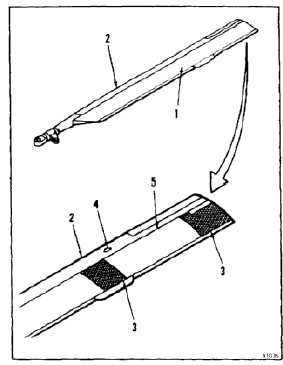TM 55-1520-240-23-4
5-66.3
TITANIUM NOSE CAP LIGHTNING STRIKE REPAIR
(Continued)
5-66.3
Do not use chlorinated solvents on
the titanium nose cap or doubler.
Contamination of titanium will result
in material failure
NOTE
In general, lightning strikes
are accompanies by arc burns,
delamination, and fragmented
fiberglass in the area of the strike.
The lightning protection strip, jumper
strips, wire mesh, and jumper wires
usually receive the most severe
damage.
1.
Wipe blade (1) with cloths damp with acetone
(E20). Dry with lint-free clean cloth (E120).
Inspect and define areas of damage (Tasks 63.1
and 63.2).
2.
Remove fragments (if any) of fiberglass skin,
loose doublers, and other damaged parts.
3.
Repair lightning strike damage on titanium nose
cap (2) as follows:
a.
Remove adhesive where discolored or loose.
Use aluminum chisel.
b.
Inspect wire mesh (3) and surrounding area.
c.
Blend out damage (4) on nose cap (2).
Remove all signs of burns or discoloration.
Make gradual blend over area at least 10
times depth of damage.
Do not break fibers of blade skin or
damage wire mesh.
d.
Remove all wire edges and grind marks.
Use abrasive paper (E8 or E9). Sand with
spanwise strokes only.
INSPECT
e.
There shall be no check marks or chordwise
cracks at nose cap trailing edge (5).
5-321

